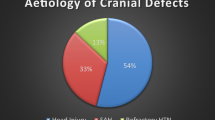Abstract
Background
Osteoplastic craniotomy in midline approaches to the posterior fossa has been proposed as an alternative to traditional osteoclastic craniectomy. Data from paediatric patients suggest that this method has advantages in terms of perioperative complications. The authors investigate midline craniotomy of the posterior fossa with a modified technique in paediatric, as well as in adult patients.
Methods
The modified technique used for this study features a suboccipital bone flap attached to the atlantooccipital membrane. The bone flap is turned downwards and left in situ during the entire surgical procedure. All patients were operated on in the sitting position. Craniotomy was achieved with standard neurosurgical instruments. Eleven adult and three paediatric patients were treated this way (average age 40 years, ranging from 2–67 years).
Results
Osteoplastic craniotomy was found to be technically feasible in adult patients. The presence of the turned down, attached bone flap did not interfere with surgery. The rate of complications associated to the operative approach was found to be low (0 wound reclosures, 0 CSF-leaks, 1 pseudomeningocele). Reattachment of the bone flap was easy and stable.
Conclusion
Midline craniotomy of the posterior fossa is feasible in adult patients, as well as in children. The technique does not seem to be associated with additional risks. Larger comparative series will be needed in order to evaluate possible advantages of the technique over osteoclastic craniectomy.


Similar content being viewed by others
References
Bucy PC (1966) Exposure of the posterior or cerebellar fossa. J Neurosurg 24:820–832
Gnanalingham KK, Lafuente J, Thompson D, Harkness W, Hayward R (2002) Surgical procedures for posterior fossa tumors in children: does craniotomy lead to fewer complications than craniectomy? J Neurosurg 97:821–826
Grover K, Sood S (2010) Midline suboccipital burr hole for posterior fossa craniotomy. Childs Nerv Syst 26:953–955
Harner SG, Beatty CW, Ebersold MJ (1995) Impact of cranioplasty on headache after acoustic neuroma removal. Neurosurgery 36:1097–1099
Kurpad SN, Cohen AR (1999) Posterior fossa craniotomy: an alternative to craniectomy. Pediatr Neurosurg 31:54–57
Ogilvy CS, Ojemann RG (1993) Posterior fossa craniotomy for lesions of the cerebellopontine angle. Technical note. J Neurosurg 78:508–509
Schessel DA, Nedzelski JM, Rowed D, Feghali JG (1992) Pain after surgery for acoustic neuroma. Otolaryngol Head Neck Surg 107(3):424–429
Wazen JJ, Sisti M, Lam SM (2000) Cranioplasty in acoustic neuroma surgery. Laryngoscope 110:1294–1297
Yasargil MG, Fox JL (1974) The microsurgical approach to acoustic neurinomas. Surg Neurol 2:393–398
Conflicts of interest
None.
Author information
Authors and Affiliations
Corresponding author
Additional information
Comment
The use of posterior fossa craniotomy as opposed to craniectomy is well established in paediatric practice, where it appears to be faster than traditional craniectomy, safe and seems to be associated with reduced wound-related morbidity and better postoperative pain control. It is interesting to see that this is now being adopted in adult practice. What Dr Prell and colleagues have added is a modification of the technique using an osteoplastic rather than free bone flap, the flap anchored at the atlantooccipital membrane. It is noteworthy that all cases were performed in the sitting position and one wonders whether the technique might be less easy for cases operated on in the more commonly used prone position, where the attached flap might have greater tendency to obscure the surgical field. As acknowledged by the authors, there will be instances where the pathology lies low in the posterior fossa or at the foramen magnum where this technique might not be applicable, and thus, patients need to be appropriately selected for this technique. The authors are to be congratulated on the minimal morbidity described in their series; however, in the paediatric population, negotiating the rim of the foramen magnum can at times be difficult (for the reasons described in the paper) given the thicker bone of the adult patients, one would anticipate that such difficulties might be encountered more frequently, and particular caution needs to be exercised in negotiating the drill at this point. I have little doubt that the technique is elegant and likely adds some extra degree of stability to the reattached bone; however, the cohort described is a relatively small series with no reference to a control group, thus, making it difficult to evaluate whether or not this modification truly confers advantage over a simple free flap.
Dominic Thompson
London, UK
Rights and permissions
About this article
Cite this article
Prell, J., Scheller, C., Alfieri, A. et al. Midline-craniotomy of the posterior fossa with attached bone flap: experiences in paediatric and adult patients. Acta Neurochir 153, 541–545 (2011). https://doi.org/10.1007/s00701-010-0924-y
Received:
Accepted:
Published:
Issue Date:
DOI: https://doi.org/10.1007/s00701-010-0924-y




